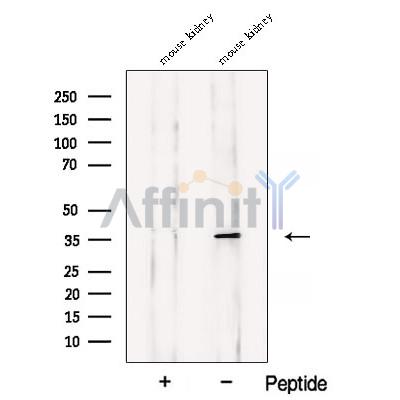ASPA Antibody - #DF12841
| Product: | ASPA Antibody |
| Catalog: | DF12841 |
| Description: | Rabbit polyclonal antibody to ASPA |
| Application: | WB IHC |
| Reactivity: | Human, Mouse, Rat, Monkey |
| Prediction: | Pig, Bovine, Horse, Sheep, Rabbit, Dog |
| Mol.Wt.: | 36 kDa; 36kD(Calculated). |
| Uniprot: | P45381 |
| RRID: | AB_2845802 |
Related Downloads
Protocols
Product Info
*The optimal dilutions should be determined by the end user. For optimal experimental results, antibody reuse is not recommended.
*Tips:
WB: For western blot detection of denatured protein samples. IHC: For immunohistochemical detection of paraffin sections (IHC-p) or frozen sections (IHC-f) of tissue samples. IF/ICC: For immunofluorescence detection of cell samples. ELISA(peptide): For ELISA detection of antigenic peptide.
Cite Format: Affinity Biosciences Cat# DF12841, RRID:AB_2845802.
Fold/Unfold
ACY 2; ACY-2; ACY2; ACY2_HUMAN; Aminoacylase 2; Aminoacylase-2; Aminoacylase2; ASP; ASPA; Aspartoacylase (aminoacylase 2, Canavan disease); Aspartoacylase (Canavan disease); Aspartoacylase; NUR 7; NUR7; OTTMUSP00000006437; RP23-213I10.1; Small lethargic;
Immunogens
A synthesized peptide derived from human ASPA, corresponding to a region within the internal amino acids.
- P45381 ACY2_HUMAN:
- Protein BLAST With
- NCBI/
- ExPASy/
- Uniprot
MTSCHIAEEHIQKVAIFGGTHGNELTGVFLVKHWLENGAEIQRTGLEVKPFITNPRAVKKCTRYIDCDLNRIFDLENLGKKMSEDLPYEVRRAQEINHLFGPKDSEDSYDIIFDLHNTTSNMGCTLILEDSRNNFLIQMFHYIKTSLAPLPCYVYLIEHPSLKYATTRSIAKYPVGIEVGPQPQGVLRADILDQMRKMIKHALDFIHHFNEGKEFPPCAIEVYKIIEKVDYPRDENGEIAAIIHPNLQDQDWKPLHPGDPMFLTLDGKTIPLGGDCTVYPVFVNEAAYYEKKEAFAKTTKLTLNAKSIRCCLH
Predictions
Score>80(red) has high confidence and is suggested to be used for WB detection. *The prediction model is mainly based on the alignment of immunogen sequences, the results are for reference only, not as the basis of quality assurance.
High(score>80) Medium(80>score>50) Low(score<50) No confidence
Research Backgrounds
Catalyzes the deacetylation of N-acetylaspartic acid (NAA) to produce acetate and L-aspartate. NAA occurs in high concentration in brain and its hydrolysis NAA plays a significant part in the maintenance of intact white matter. In other tissues it act as a scavenger of NAA from body fluids.
Cytoplasm. Nucleus.
Brain white matter, skeletal muscle, kidney, adrenal glands, lung and liver.
Belongs to the AspA/AstE family. Aspartoacylase subfamily.
Research Fields
· Metabolism > Amino acid metabolism > Alanine, aspartate and glutamate metabolism.
· Metabolism > Amino acid metabolism > Histidine metabolism.
· Metabolism > Global and overview maps > Metabolic pathways.
Restrictive clause
Affinity Biosciences tests all products strictly. Citations are provided as a resource for additional applications that have not been validated by Affinity Biosciences. Please choose the appropriate format for each application and consult Materials and Methods sections for additional details about the use of any product in these publications.
For Research Use Only.
Not for use in diagnostic or therapeutic procedures. Not for resale. Not for distribution without written consent. Affinity Biosciences will not be held responsible for patent infringement or other violations that may occur with the use of our products. Affinity Biosciences, Affinity Biosciences Logo and all other trademarks are the property of Affinity Biosciences LTD.



